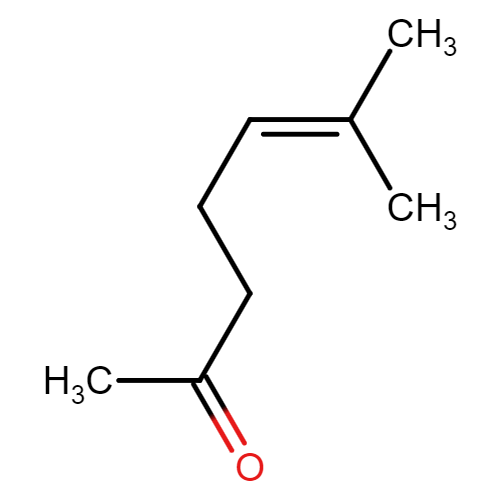6-Methyl-5-Hepten-2-one (Sulcatone)
| Compound Structure: |

|
||||||||||||||||||||||||||||||||||||||||||||||||||
|---|---|---|---|---|---|---|---|---|---|---|---|---|---|---|---|---|---|---|---|---|---|---|---|---|---|---|---|---|---|---|---|---|---|---|---|---|---|---|---|---|---|---|---|---|---|---|---|---|---|---|---|
| Synonyms: | 6-METHYL-5-HEPTEN-2-ONE;110-93-0;Sulcatone;2-Methyl-2-hepten-6-one;5-HEPTEN-2-ONE, 6-METHYL-;METHYL HEPTENONE;6-Methyl-5-heptene-2-one;2-Oxo-6-methylhept-5-ene;Heptenone, methyl-;2-Methyl-6-oxo-2-heptene;prenylacetone | ||||||||||||||||||||||||||||||||||||||||||||||||||
| Compound ID: | NMPC-474 | ||||||||||||||||||||||||||||||||||||||||||||||||||
| PubChem ID: | |||||||||||||||||||||||||||||||||||||||||||||||||||
| Molecular Formula: | C8H14O | ||||||||||||||||||||||||||||||||||||||||||||||||||
| Canonical SMILES: | CC(=CCCC(=O)C)C | ||||||||||||||||||||||||||||||||||||||||||||||||||
| InChIKey: | UHEPJGULSIKKTP-UHFFFAOYSA-N | ||||||||||||||||||||||||||||||||||||||||||||||||||
| About the compound: | Sulcatone, known in the scientific community as 6-Methyl-5-hepten-2-one, is distinguished by its citrusy, fruity scent and is a colorless liquid resembling water in appearance. Its formula is C8H14O. This methylated ketone is notably effective as an attractant for the Aedes aegypti mosquito, which possesses an odor receptor gene (Or4) specifically sensitive to sulcatone. This trait renders it particularly valuable for research aimed at vector control and mitigating the spread of mosquito-transmitted diseases[1]. Studies have also shed light on sulcatone's importance in mosquitoes' selection of egg-laying sites. It has been identified as one of the semiochemicals critical for directing mosquitoes to preferred oviposition environments. This insight suggests the possibility of employing such compounds to devise methods for controlling mosquito populations by influencing their reproductive behaviors. Sulcatone, together with other molecules like β-caryophyllene, decanal, and limonene, has been found to provoke antenna responses in mosquitoes during gas chromatography-electroantennographic detection (GC-EAD) studies, showcasing its pivotal influence on mosquito activity[2]. Additionally, research into sulcatone has extended to its application in bioinsecticide development, targeting pests such as Spodoptera littoralis. These investigations reveal sulcatone's wider potential in pest management and control strategies, presenting an eco-friendlier alternative to conventional chemical insecticides[3]. References 1. Wikipedia contributors. "Sulcatone." Wikipedia, The Free Encyclopedia. Last modified May 2, 2021. https://en.wikipedia.org/wiki/Sulcatone. 2. Okumu, Fredros O., et al. "Controlling mosquitoes with semiochemicals: a review." Parasites & Vectors, vol. 13, no. 1, 2020. https://parasitesandvectors.biomedcentral.com/articles/10.1186/s13071-019-3495-3. 3. Vasileiadis, S., et al. "Fermentation as an Alternative Process for the Development of Bioinsecticides." Fermentation, vol. 5, no. 3, 2019. https://www.mdpi.com/2311-5637/5/3/58. GHS Hazard Statements • H226 (100%): Flammable liquid and vapor [Warning Flammable liquids] • H319 (77.33%): Causes serious eye irritation [Warning Serious eye damage/eye irritation] |
||||||||||||||||||||||||||||||||||||||||||||||||||
| Properties: |
Chemical
and Physical Properties
Source: PubChem |
||||||||||||||||||||||||||||||||||||||||||||||||||
| Source Species: |
Cymbopogon citratus Hirsute Palisota Pteris togoensis |